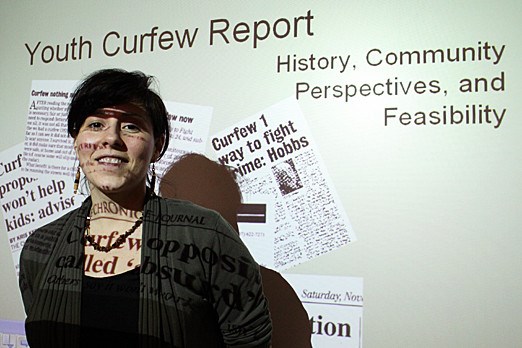Despite overwhelming opposition to a citywide curfew for youth, members of the Thunder Bay Crime Prevention Council say they will continue to present the idea to city council as an option.
Thunder Bay Mayor Keith Hobbs brought up the idea about a citywide curfew for young residents during last fall's municipal election. Council approved a feasibility study on the matter to see if keeping youth 16-years-old and younger in their homes from midnight to 6 a.m. would impact the city’s crime rate.
The city’s crime prevention council on Tuesday reviewed a study on how the community felt about the curfew.
Amy Siciliano, co-ordinator of the Thunder Bay Crime Prevention Council, interviewed the 32 crime prevention council members and found that 70 per cent were against the idea of a curfew. About 12 per cent were supportive while another 18 per cent remained undecided.
She also interviewed 498 students from seven different high schools. She found that 68 per cent were against the idea of a curfew, while 19 per cent were for the idea, three per cent were unsure and nine per cent didn’t vote.
The members who were against the curfew said they didn’t want to send youth back to an unsafe home and recommended the city should invest in a safe house.
It took many years for Linda Bruins, co-ordinator for Evergreen A United Neighbourhood, to earn the trust of troubled youths. She said earning that kind of trust should be the focus of what the council is doing.
"I think we have to build a relationship of trust and getting to know the youth and getting to know what their issues are instead of speaking for them," Bruins said. "I think a safe house would be wonderful. I think there are periods when all of us are vulnerable. As an adult, we have more options of what we can do for our safety. As children we don’t."
She added that she felt a curfew could force youth from troubled homes to move off the street and hide somewhere where they couldn’t receive any kind of assistance.
Siciliano interviewed a variety of sources to ensure it reflected how the community felt toward a potential curfew. She found that the majority of people were against the idea of a curfew, but everyone agreed that something had to be done.
One of the more common ideas to come up was a community safe house, she said.
"There was a (safe house) in the city at one point," Siciliano said. "People talked about bringing something like that back to the community. A lot of people also talked about a barrier-free place for youth to hang out."
Siciliano couldn’t say for sure if a curfew would complement a safe house, but would be open to exploring the idea further. But from the research and publications on the subject, curfews don’t have a preventative effect on reducing crime or reducing victimization, she said.
Hobbs continued to voice his support and brought up an earlier idea of a potential year-long trial run to see how affective a curfew could be.
"From what I’ve seen tonight, there’s not the stomach here from this crime committee to support a curfew," Hobbs said. "I saw that loud and clear tonight. However, there was a lot of research done with the youth but there was no research done with the parents of those youth and I think that was sadly lacking. I think we have to do more studying in that regard."
Hobbs said he liked the idea of a safe house and didn’t care what the outcome was as long as the youth were safely off the streets.
"Let’s get the kids of the streets," he said. "You tell me why a child of 15 has to hang out with a group at 2 a.m.?"
The crime council will present their study along with its corporate report to city council on April 18.
Sign in or register
- Messages
- Post a Listing
- Your Listings
- Your Profile
- Your Subscriptions
- Your Likes
- Your Business
- Support Local News
- Payment History
Registered Users
Already have an account?
New Users
Create a free account.
